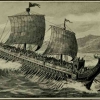Chapter A. Basic Concepts of Management Information Systems
1. Definition of Information Systems
o System: a set of interrelated elements that work together to achieve a goal. Systems are divided into open systems (there is interaction with the environment) and closed systems (minimal interaction, with clear objectives and feedback).
o Information: data that has been processed to be meaningful for decision making.
o Management: the art of managing work through others, including planning, implementation, evaluation, and supervision.
2. The Essence of MIS
o MIS is a data processing system that produces relevant information to reduce decision uncertainty.
o MIS existed before computers, but is now ICT-based (computers, internet, satellites, telephones, radio/TV, cameras).
3. Benefits of ICT-based SIMDIK
o Increases the productivity of school administrators.
o Supports planning, supervision, evaluation, and learning.
4. Principles of ICT-based SIMDIK
o Schools are required to manage effective SIM, provide information facilities, appoint information officers, and report to the education office.
o Communication between members of the education community must be efficient.
5. Limitations & Advantages of IT-based SIM
o Limitations: high costs, slow access, prone to distractions & cybercrime.
o Advantages: high productivity, accurate, repetitive, capable of managing complex data.
Chapter B. SIMDIK as IT Implementation in Education
1. Definition of SIMDIK
o Information system for school management (kindergarten to high school), ranging from registration, academics, finance, to alumni.
o Compliant with JARDIKNAS standards, facilitating reporting to the education office.
2. Objectives of SIMDIK
o Providing comprehensive information.
o Encourage public participation.
o Transparency in resource utilization.
o Improve ICT literacy among teachers and students.
o Provide easy access for school members.
3. Functions of SIM
o Reduce decision uncertainty.
o Provide a rational basis for selecting policy alternatives.
4. The Role of SIM in Educational Decisions
o Helping leaders make rational decisions with 4 models:
Rational model, Political model, Anarchy model, and Process model.
Chapter C. Transformation Systems in SIM & Their Applications
1. System Development
o Computer and internet technology enables fast, globally connected, and efficient data processing.
o The internet facilitates data collection, transparency, and information distribution.
2. Types of Information Systems by Management Level
o Top level: strategic planning & policy.
o Middle level: tactical planning.
o Lower level: operational supervision.
Compliant with JARDIKNAS standards.
o Integrated data.
o Fast & accurate reports.
o Enhances the image of educational institutions.
4. Benefits for Schools, Teachers, Students, & Parents
o Schools: monitor students, store databases, improve services.
o Teachers & students: access to extensive information, global communication, scholarship opportunities.
o Parents: check attendance & grades via SMS/online.
Chapter D. Problems in SIMDIK
1. Suboptimal educational services due to weak data integration.
2. Lack of collaboration between curriculum administrators and school management.
3. Discontinuous information accountability due to multiple data versions.
4. Slow and inaccurate information at the senior management level.
Conclusion
SIMDIK is an important tool for improving the quality of IT-based education management. This system integrates data, increases productivity, strengthens transparency, and supports rational decision-making. However, the implementation of SIMDIK still faces obstacles in the form of costs, limited access, weak collaboration, and information accountability. With the development of a more integrated system, SIMDIK can become the backbone of modern education management.
Follow Instagram @kompasianacom juga Tiktok @kompasiana biar nggak ketinggalan event seru komunitas dan tips dapat cuan dari Kompasiana. Baca juga cerita inspiratif langsung dari smartphone kamu dengan bergabung di WhatsApp Channel Kompasiana di SINI







